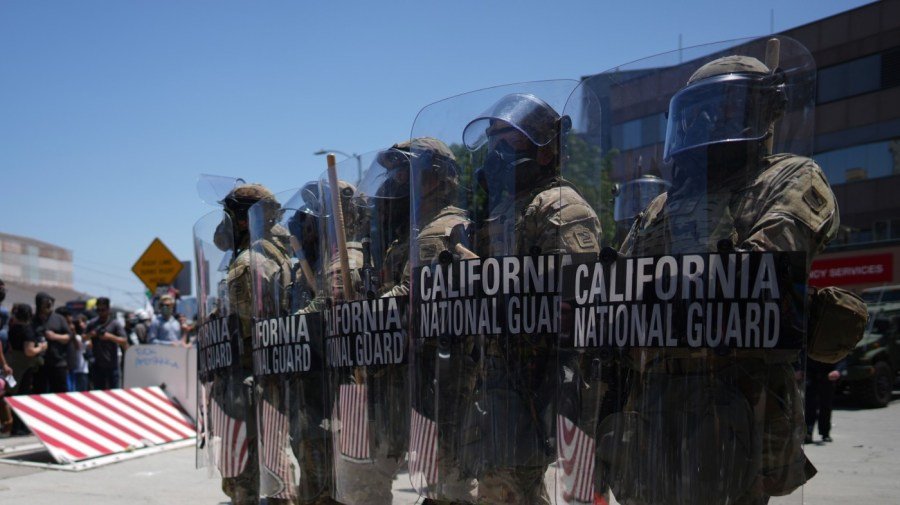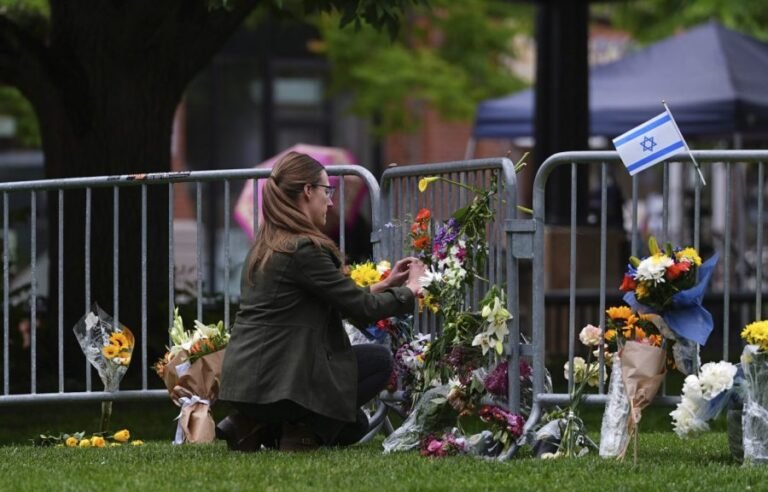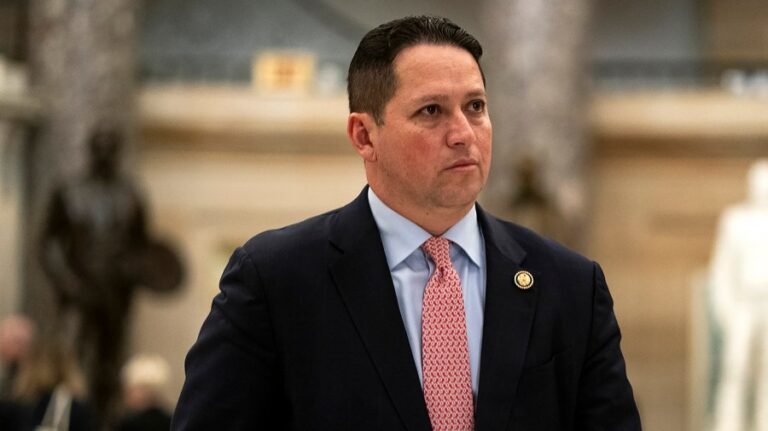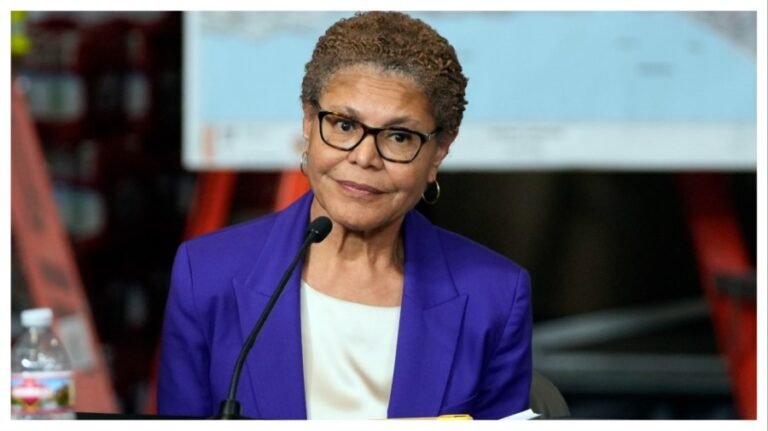
President Trump’s use of the National Guard to respond to protests in California is raising questions about the extent he’ll go to respond to scrutiny of his immigration policies, including whether he may ignite the Insurrection Act.
It’s normally the governor who calls in the National Guard, but Trump bypassed California Gov. Gavin Newsom (D) in sending troops to the streets of Los Angeles.
Protests erupted over the weekend in U.S. Immigration and Customs Enforcement (ICE) officers conducted workplace raids in search of those suspected of being unlawfully present.
Neither the state nor city officials have requested federal assistance, sparking criticism of Trump when on Saturday he signed an order authorizing the use of 2,000 National Guard troops, though so far, just 300 have arrived in the city.
Elizabeth Goitein, a national security law expert at the Brennan Center for Justice, called the move “a huge red flag for democracy.”
“There’s an even bigger problem with Trump’s order. He isn’t just deploying Guard forces to Los Angeles. In fact, his memorandum doesn’t even mention LA. It authorizes deployment ‘at locations where protests against [ICE] functions are occurring or are likely to occur,’” she wrote on X, noting that protests of Trump’s immigration policies have been happening across the country.
“No president has ever federalized the National Guard for purposes of responding to potential future civil unrest anywhere in the country. ‘Preemptive’ deployment is literally the opposite of deployment as a last resort. It would be a shocking abuse of power and the law,” she added.
“In short: don’t let the absence of the words ‘Insurrection Act’ fool you.”
Trump has not yet tapped the Insurrection Act, a power used sparingly in U.S. history that allows for use of the military to quell a rebellion.
But he has thus far been coy about whether he would tap the greater authorities allowed under the Insurrection Act.
“Depends on whether or not there’s an insurrection,” he told reporters Sunday, even as he added that he did not believe there was one currently, saying, “No. But you’ve got violent people.”
“We’re just going to see what happens. If we think there’s a serious insurrection …we’re going to have law and order.”
When asked what the bar would be for sending in the Marines, Trump said, “The bar is what I think it is.”
Sarah Mehta, deputy director of government affairs at ACLU, said the far-reaching nature of Trump’s order was an effort “to give himself a blank check to use the military whenever he wants to go after his critics.”
“The last time that the president went over the objection of a governor to deploy National Guard troops into their state was 1965, and it was when President Johnson was doing so for desegregation and to protect civil rights protesters,” she said.
“Whereas right now, we’re seeing basically the opposite. We’re seeing the president use the National Guard as a private army to punish people who are criticizing his policies.”
Trump has long flirted with using the Insurrection Act, including during protests over the killing of Goerge Floyd during his first term in office. He also referenced the possibility of doing so during the campaign should there be protests of his victory, saying he would do so in Democrat-run states.
Mehta described the current state of play as “sort of a run around the insurrection act.”
“It’s a way that Trump has been trying to use military, again as a private army, essentially, in order to effectuate their dystopian deportation dream,” she said.
“And it comes at the expense of everything else that National Guard and Army units either should be doing or certainly are trained for doing.”
Steve Vladeck, a professor at Georgetown Law, said Trump’s order does have some limitations.
He noted that the troops on the ground have no power to conduct any immigration enforcement and have largely been assigned to protect federal property.
However, there have been clashes with protestors, including the firing of rubber bullets and use of tear gas.
Vladeck argued their deployment alone risks exacerbating tension.
“That’s a significant (and, in my view, unnecessary) escalation of events in a context in which no local or state authorities have requested such federal assistance. But by itself, this is not the mass deployment of troops into U.S. cities that had been rumored for some time,” he wrote in a Saturday blog post after Trump’s order was signed.
“There is the possibility that that’s a feature, and not a bug—that this is meant as a precursor, with federalizing a modest number of National Guard troops today invoked, some time later, as a justification for more aggressive responses to anti-ICE protests, including, perhaps invocation of the Insurrection Act,” he added.
“In other words, it’s possible that this step is meant to both be and look modest so that, if and when it ‘fails,’ the government can invoke its failure as a basis for a more aggressive domestic deployment of troops.”
Newsom has accused Trump and the Department of Defense of lying about conditions on L.A.’s streets, saying the Trump administration escalated the matter simply by deploying troops.
“Donald Trump has manufactured a crisis and is inflaming conditions,” the governor wrote on X on Monday.
California is planning to challenge Trump’s directive, with Newsom saying the lawsuit would challenge Trump’s federalizing of the California National Guard without the state’s consent.
“He’s putting fuel on this fire, ever since he announced he was taking over the National Guard — an illegal act, an immoral act, an unconstitutional act,” Newsom said on MSNBC,
“And we’re going to test that theory with a lawsuit.”
Trump officials in the past have been critical of any efforts for the president to control the National Guard.
“If Joe Biden federalizes the National Guard, that would be a direct attack on states’ rights,” Homeland Security Secretary Kristi Noem said in February of last year while she was still serving as governor of South Dakota.
“Over the last several years, we’ve seen Democrats try to take away our Freedoms of religion, assembly, and speech. We can’t let them take away our right to defend ourselves, too.”
Trump on Sunday defended the move, saying he told Newsom “take care of this, otherwise I’m sending in the troops.”
“We’re going to have troops everywhere,” Trump told reporters.
“We’re not going to let this happen to our country. We’re not going to let our country be torn apart.”


